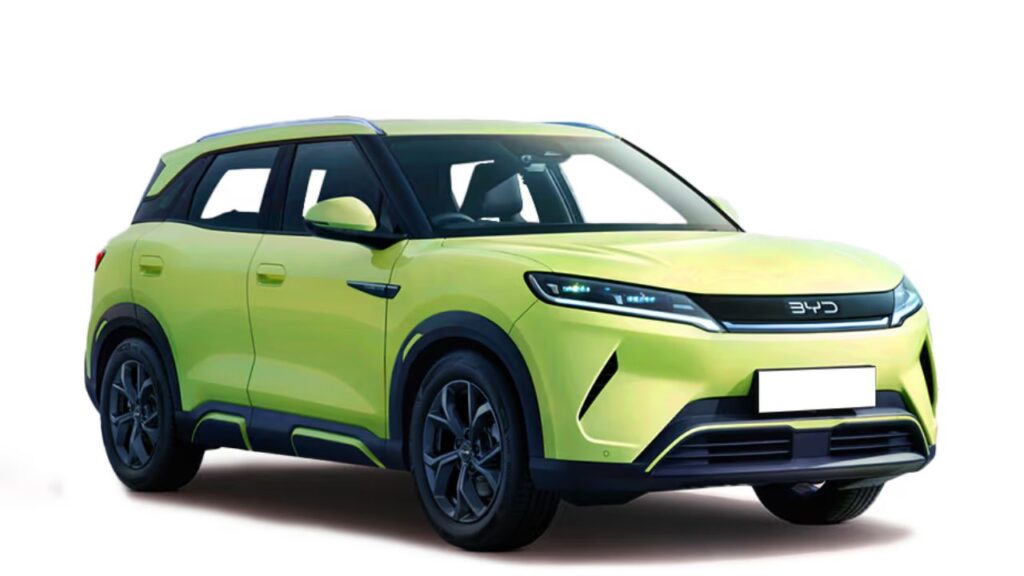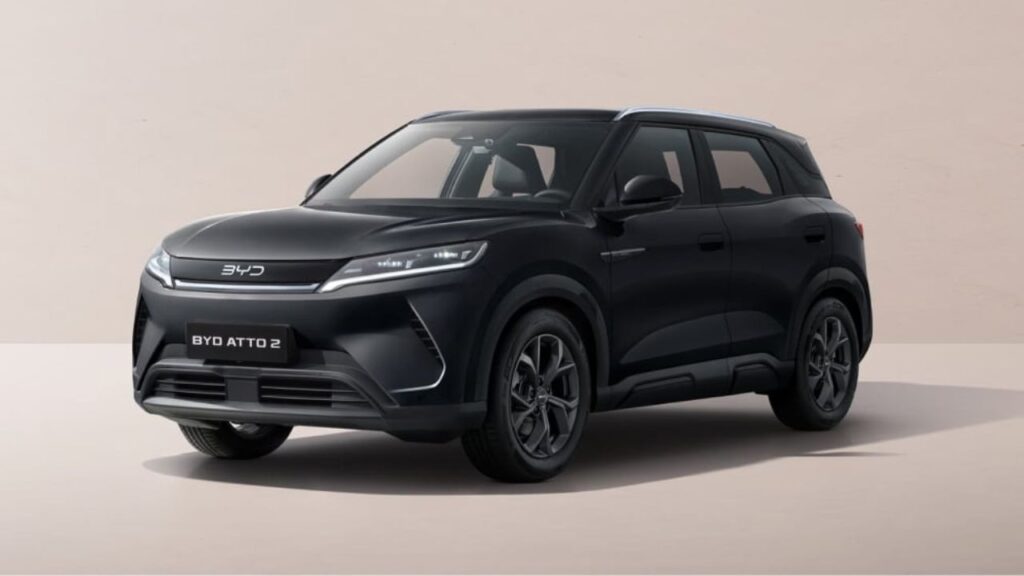The compact SUV segment faces its most significant disruption in years as BYD launches the Atto 3 into Australian showrooms. This electric vehicle represents a fundamental challenge to established players like the Mazda CX-5, offering zero-emission driving without compromising on practicality or performance.
BYD’s aggressive pricing strategy and comprehensive feature list position the Atto 3 as a serious contender rather than a niche alternative. The vehicle’s arrival signals the beginning of widespread electric vehicle adoption in Australia’s most popular SUV category.

Electric Revolution in Compact SUV Segment
Traditional compact SUVs built their reputations on versatility, fuel efficiency, and family-friendly practicality. The Atto 3 maintains these core attributes while eliminating tailpipe emissions and reducing operating costs through electric drive technology.
Market research indicates growing consumer interest in electric alternatives, particularly among environmentally conscious buyers who refuse to compromise on utility. The Atto 3 directly addresses this demographic with modern electric technology wrapped in familiar SUV packaging.
BYD’s Strategic Market Entry
Chinese automaker BYD brings significant electric vehicle experience to the Australian market, having dominated domestic Chinese EV sales for several years. This experience translates into mature technology and manufacturing expertise that benefits Australian consumers.
The company’s vertical integration across battery production, electric motors, and vehicle assembly provides cost advantages that enable competitive pricing. These structural benefits allow BYD to offer premium features at mainstream price points.
Timing and Market Conditions
Australia’s expanding charging infrastructure and growing environmental awareness create favorable conditions for electric SUV adoption. Government incentives in some states further improve the financial proposition for potential EV buyers.
Rising fuel costs make electric vehicles increasingly attractive from a total cost of ownership perspective. The Atto 3’s arrival coincides with peak consumer interest in alternatives to traditional internal combustion engines.
Design Philosophy: Modern Minimalism
BYD’s design team adopted a clean, contemporary approach that prioritizes functionality over flashy styling elements. The Atto 3’s exterior features smooth lines and practical proportions that optimize aerodynamic efficiency while maintaining SUV proportions.
LED lighting technology throughout creates a modern appearance while providing superior illumination performance. The charging port integration appears seamless rather than added as an afterthought, demonstrating thoughtful electric vehicle design.
Interior Space Optimization
Electric vehicle packaging advantages become apparent inside the Atto 3, where the flat floor and compact drivetrain create impressive interior volume. Passenger space exceeds expectations for a vehicle in this price category, particularly rear seat accommodation.
Premium materials and build quality rival more expensive SUVs, suggesting BYD’s commitment to competing on quality rather than price alone. Attention to detail in trim selection and assembly demonstrates manufacturing sophistication.
Technology Integration and User Interface
The rotating touchscreen infotainment system serves as the cabin’s focal point, providing access to navigation, entertainment, and vehicle settings. This feature differentiates the Atto 3 from conventional alternatives while offering practical benefits.
Physical controls for climate control and frequently used functions maintain ease of use during driving. The interface balance between touchscreen functionality and traditional controls suits various user preferences and driving conditions.
Electric Powertrain Performance and Efficiency
The Atto 3’s electric motor delivers instant torque characteristic of electric vehicles, providing responsive acceleration that exceeds most conventional SUVs in this segment. Power delivery remains smooth and linear across the entire speed range.
Single-motor front-wheel-drive configuration keeps costs manageable while providing adequate performance for typical SUV applications. The system prioritizes efficiency over maximum performance, aligning with family SUV buyer priorities.
Battery Technology and Range Capabilities
BYD’s Blade Battery technology provides the foundation for the Atto 3’s energy storage system. This lithium iron phosphate chemistry prioritizes safety and longevity over maximum energy density, resulting in a robust and reliable power source.
Real-world range testing demonstrates the Atto 3 can achieve approximately 320 kilometers under typical driving conditions. This capability covers most daily driving requirements while leaving adequate reserve for unexpected journeys.
Charging Infrastructure Compatibility
The Atto 3 supports both AC and DC charging protocols, ensuring compatibility with Australia’s expanding charging network. Home charging using standard domestic outlets provides overnight replenishment for typical daily driving.
DC fast charging capabilities enable longer journeys by reducing charging times at highway service centers. The vehicle can accept charging rates up to 80kW, allowing 10-80% charging in approximately 45 minutes under optimal conditions.
Competitive Analysis: Atto 3 vs. Mazda CX-5
The Mazda CX-5 has established itself as a benchmark in the compact SUV segment through refined driving dynamics, premium interior quality, and strong reliability reputation. The Atto 3 challenges these strengths through different technological approaches and value propositions.
Pricing represents the most immediate point of comparison, with the Atto 3’s electric drivetrain potentially offering lower total ownership costs despite similar purchase prices. Fuel savings and reduced maintenance requirements favor the electric alternative over time.
Feature and Equipment Comparison
Standard equipment levels reveal BYD’s strategy to compete through comprehensive feature lists rather than basic entry-level offerings. Advanced safety systems, premium audio, and connectivity features come standard on base Atto 3 variants.
The CX-5’s reputation for build quality and materials sets high standards that the Atto 3 must match to succeed in the premium compact SUV segment. Initial quality assessments suggest BYD has invested significantly in meeting these expectations.
Driving Dynamics and Character
Electric motor characteristics create a fundamentally different driving experience compared to the CX-5’s refined internal combustion engines. The Atto 3’s silent operation and instant response appeal to buyers seeking modern, sophisticated transportation.
Suspension tuning prioritizes comfort over sporty handling, reflecting the Atto 3’s positioning as a practical family vehicle. Road noise isolation and ride quality compete favorably with established alternatives in normal driving conditions.
Practical Considerations for Australian Conditions
Australia’s vast distances and variable climate conditions present unique challenges for electric vehicles. The Atto 3’s range capabilities suit urban and suburban applications excellently while requiring planning for longer regional journeys.
Air conditioning usage in hot climates can impact range significantly, though the Atto 3’s thermal management systems help minimize efficiency losses. Pre-conditioning while connected to charging reduces the impact on driving range.
Urban vs. Regional Suitability
City-based buyers will appreciate the Atto 3’s quiet operation, zero local emissions, and low operating costs. Parking advantages include access to some dedicated EV parking spaces and potential toll road discounts.
Regional buyers face greater challenges related to charging infrastructure availability and longer travel distances. However, the Atto 3’s range capabilities handle most regional commuting patterns when combined with home charging solutions.
Climate and Environmental Performance
Hot weather testing demonstrates the Atto 3’s ability to maintain performance and efficiency in challenging Australian conditions. Battery thermal management systems protect against extreme temperatures while maintaining optimal operating conditions.
Cold weather performance, while less relevant in most Australian locations, remains adequate for occasional mountain driving or southern winter conditions. The electric drivetrain provides consistent performance across temperature ranges.
Safety Technology and Protection Systems
Modern safety requirements demand comprehensive protection systems, and the Atto 3 delivers advanced features as standard equipment. Autonomous emergency braking, lane keeping assistance, and blind spot monitoring provide active protection for occupants and other road users.
The vehicle’s structure incorporates high-strength materials and advanced crumple zones designed to modern safety standards. Multiple airbags provide comprehensive protection for all seating positions in various collision scenarios.
Electric Vehicle-Specific Safety Features
Battery protection systems include impact sensors that disconnect high-voltage systems in collision scenarios. These safety measures address specific concerns related to electric vehicle accidents and emergency response procedures.
Pedestrian warning systems alert nearby pedestrians to the vehicle’s presence during low-speed operation when electric motor noise is minimal. These features help prevent accidents in parking areas and residential neighborhoods.
Advanced Driver Assistance Systems
Adaptive cruise control with stop-and-go functionality reduces driver fatigue during highway driving and heavy traffic conditions. The system maintains safe following distances and can bring the vehicle to complete stops when necessary.
Traffic sign recognition and speed limit alerts help drivers comply with changing road conditions. These systems work together with other safety technologies to create a comprehensive protection suite.
Total Cost of Ownership Analysis
Electric vehicles typically offer significant operational cost advantages compared to internal combustion alternatives. The Atto 3’s electricity consumption costs substantially less than equivalent fuel expenses, even accounting for recent energy price increases.
Maintenance requirements are minimal compared to conventional SUVs, with no oil changes, spark plugs, or complex engine components requiring regular attention. Brake pad life extends significantly due to regenerative braking systems.
Depreciation and Resale Value Considerations
Electric vehicle resale values remain somewhat uncertain due to rapid technology development and limited historical data. However, growing EV acceptance and fuel cost trends suggest strong long-term value retention potential.
Government incentives and changing regulations may continue favoring electric vehicles, potentially supporting resale values. The Atto 3’s comprehensive warranty coverage provides additional confidence for buyers concerned about long-term value.
Insurance and Registration Costs
Insurance costs for electric vehicles vary by provider and location, though some insurers offer discounts for environmentally friendly vehicles. The Atto 3’s advanced safety systems may qualify for additional premium reductions.
Registration costs in most states treat electric vehicles similarly to conventional alternatives, though some jurisdictions offer reduced fees or exemptions. These savings contribute to lower total ownership costs over time.
Market Positioning and Target Demographics
BYD positions the Atto 3 to attract environmentally conscious families who want electric vehicle benefits without compromising SUV practicality. This strategy targets buyers considering both environmental impact and family transportation needs.
Professional buyers appreciate the Atto 3’s modern image and low operating costs. The vehicle’s quiet operation and advanced technology features suit corporate and executive applications where image and efficiency matter.
Early Adopter vs. Mainstream Appeal
Initial Atto 3 buyers likely include early EV adopters excited by new technology and environmental benefits. However, mainstream appeal depends on demonstrating reliability, convenience, and value comparable to conventional alternatives.
Word-of-mouth recommendations from satisfied early adopters will prove crucial for broader market acceptance. BYD’s success depends on delivering positive ownership experiences that encourage referrals and repeat purchases.
Fleet and Commercial Applications
Government and corporate fleets increasingly specify electric vehicles to meet environmental targets and reduce operational costs. The Atto 3’s combination of efficiency and SUV practicality makes it suitable for various fleet applications.
Commercial users who primarily operate in urban areas benefit most from electric vehicle advantages. Delivery services, real estate agents, and other professionals with predictable driving patterns represent key target markets.
Charging Infrastructure and Home Installation
Successful electric vehicle ownership depends heavily on convenient charging access. The Atto 3’s charging flexibility accommodates various user situations, from apartment dwellers relying on public charging to homeowners with dedicated wallbox installations.
Home charging installation costs vary significantly based on electrical system requirements and installation complexity. Government rebates in some states help offset these expenses for eligible buyers.
Public Charging Network Compatibility
Australia’s public charging network continues expanding rapidly, with major retailers, fuel companies, and dedicated charging providers installing new stations regularly. The Atto 3’s compatibility with multiple charging standards ensures broad network access.
Charging app integration simplifies finding, accessing, and paying for public charging services. The vehicle’s navigation system can route trips to include charging stops, reducing range anxiety for longer journeys.
Workplace and Destination Charging
Many employers now provide workplace charging as an employee benefit, making electric vehicles more practical for commuters. Shopping centers, hotels, and tourist destinations increasingly offer charging facilities for customer convenience.
Destination charging availability influences travel planning and vehicle suitability for various lifestyle requirements. The growing network makes electric SUVs like the Atto 3 increasingly practical for diverse user needs.
Future Technology Development
BYD’s continued investment in electric vehicle technology suggests ongoing improvements in battery capacity, charging speed, and system efficiency. Future Atto 3 variants may offer enhanced capabilities and features.
Over-the-air software updates enable new features and improvements without requiring hardware changes. This capability extends the vehicle’s useful life and maintains competitiveness against newer alternatives.
Autonomous Driving Technology Integration
Advanced driver assistance systems in the current Atto 3 provide a foundation for future autonomous capabilities. Camera and sensor arrays support enhanced automation as technology and regulations develop.
Vehicle-to-everything communication technology could eventually enable coordinated traffic management and improved safety. These systems require significant infrastructure investment but offer long-term benefits for all road users.
Battery Technology Evolution
Next-generation battery chemistry developments promise improved energy density, faster charging, and longer service life. The Atto 3’s modular design may accommodate these advances through future updates or replacements.
Recycling programs for end-of-life batteries address environmental concerns while recovering valuable materials. These initiatives support sustainable electric vehicle adoption and reduce resource consumption.
Service Network and Ownership Support
BYD’s expanding Australian service network provides essential support for Atto 3 owners. Authorized service centers receive specialized training and equipment to maintain electric vehicle systems properly.
Mobile service programs bring routine maintenance and minor repairs to customer locations, improving convenience and reducing downtime. These services particularly benefit fleet operators and busy professionals.
Warranty Coverage and Protection
Comprehensive warranty coverage protects Atto 3 buyers against unexpected repairs and builds confidence in BYD’s commitment to quality. Extended warranty options provide additional peace of mind for long-term ownership planning.
Battery warranty terms specifically address electric vehicle owner concerns about expensive component replacement. The coverage duration and conditions directly influence total cost of ownership calculations.
Parts Availability and Technical Support

Global parts distribution networks ensure reasonable lead times for both routine maintenance and accident repairs. BYD’s international presence supports consistent parts availability across multiple markets.
Technical support programs help service providers diagnose and repair complex electric vehicle systems. These resources ensure consistent service quality and reduce repair times for Atto 3 owners.
Environmental Impact and Sustainability
The Atto 3’s environmental benefits extend beyond zero tailpipe emissions to include reduced noise pollution and improved urban air quality. These advantages become more significant as electric vehicle adoption increases.
Lifecycle analysis demonstrates environmental benefits throughout the vehicle’s operational life, particularly as electricity generation incorporates increasing renewable energy sources. Manufacturing emissions are typically offset within 2-3 years of normal operation.
Manufacturing and Supply Chain Considerations
BYD’s manufacturing processes increasingly incorporate sustainable practices and materials to minimize environmental impact during production. These initiatives address growing consumer awareness of environmental issues beyond operational emissions.
Supply chain transparency and ethical sourcing become increasingly important as electric vehicle production scales. Responsible material sourcing supports sustainable industry development and consumer confidence.
Frequently Asked Questions
Q1: What is the real-world driving range of the BYD Atto 3?
The BYD Atto 3 achieves approximately 320 kilometers of real-world driving range under typical conditions, with variations based on driving style, weather, and terrain.
Q2: How long does it take to charge the Atto 3 at home?
Home charging with a 7kW wallbox takes approximately 7-8 hours for a full charge, while standard domestic outlets require 12-15 hours for complete charging.
Q3: What warranty coverage does BYD provide on the Atto 3?
BYD offers 6 years/150,000km vehicle warranty and 8 years/160,000km battery warranty, providing comprehensive protection for Australian buyers.
Also Read: Isuzu D-Max Blade Revealed as New Hero Model in Australia

